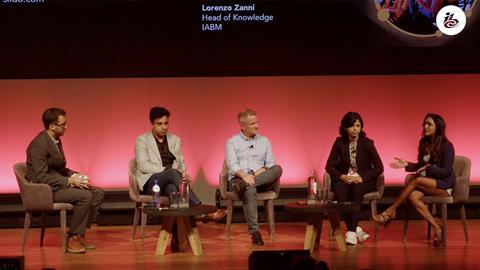One of the topics discussed at IBC2023 was a body of research undertaken by the International Trade Association for Broadcast & Media Technology (IABM).
The research looked into the drivers for change in the media tech sector, under the pressures of global inflation, strikes, limited resources and challenging revenue conditions.

AI was one of the recurring themes of the panel, made up of key figures from media tech companies from across the globe. However, the varying strategies they employ can be used to make a playbook of how companies in the space, and other areas in media, might go about using AI.
AI in a changing world
“You can’t do things the same way anymore. That’s what we’re learning,” said Jade Kurian, President and co-founder of latakoo, a workflow specialist that partners with video production companies and broadcasters to optimise their operations.
“They’re dealing with the same thing we’re dealing with. The cost of hardware and services: all up. and inflation, right?”
Watch now IABM Session: State of MediaTech - Key drivers of change in 2023 and beyond
These pressures naturally lead many to seek to make efficiencies with the use of AI in their workflow. ”Every single client has asked about how we’re going to use AI and what features are going to come out of it,” said Kurian. However, she said the key is in identifying a concrete problem that AI tools can actually solve.
“The really important thing with AI is that any system that wants to use AI, needs to have a conversation with their team about how they are going to use it,” she said.
“We met with one of the large media groups in the US… they asked us to come in. They had a panel where we spoke, my co-founder and I. They brought in all their journalists top listen to us, a company bringing in some AI to our workflow tools, and we got a chance to speak to them about what they want to see.”
“The number one thing was how do you start your news day? How does news get started? It’s all the story ideas that come in, through emails and press releases. How can AI solve that problem.”
Kurian is realistic about the goals for AI in the current moment, as an efficiency and cost-saving measure.
“That’s what they really want, efficiencies. Especially at a time like this when we’re looking at layoffs. We’re looking at doing more with less so that’s where AI becomes really important.”
Allen Broome, CEO of Mediakind offered insight into other ways AI can be integrated into a video production practice.
“[AI] is changing everything we do, and it’s real. There are real use cases for each part of the work flow,” he said
Mediakind operates in content delivery and encoding for linear, on-demand, and OTT, offering plenty of avenues for exploration.
“Specifically for us, we’ve incorporated AI to be more efficient as a company. Our product team uses generative AI to help with marketing releases, product documentation,” said Broome. This is a use of AI the average member of the public who has simply played around with ChatGPT might guess, but there’s much more.
AI as an engineering tool
“We’ve incorporated efficient AI models into our live linear encoders,” said Broome. “Because as the codecs get more and more complicated it takes more processing to search those decision trees and we use AI to minimise that search pattern and make the decision quicker. It helps us with low latency for live events, and in ensuring while they produce the best video quality are still efficient.”

Mediakind also uses AI to exploit one other theme of the moment, repurposing existing content to re-monetise it or make it appear fresh again.
“We leverage AI to help upscale legacy content so it can be re-monetised, taking old SD assets and upscaling those to HD. I think there’s a lot of opportunity in AI and it changes daily,” said Broome.
Practical considerations in the cloud
All the industry players agreed that in order to use AI effectively, though, this content needs to be housed in the cloud.
“If you’re not moving your workflow into the cloud, you’re not going to have access to the innovation that’s happening around AI,” said Broome.
This is exactly what India’s ZEE5 is in the process of doing, as CTO Kishore Krishnamurthy explained.
“To run all of these AI and ML models we need all the content to be on the cloud to run it efficiently,” he said.
“We are in the process of moving all of our content to the cloud. We are talking about 25-30 petabytes of content here.”
He found his experience of the market to be quite different to the other panel members, but ZEE5 reaction to it is not all that different.
“From an Indian perspective, a lot of [reports are] contrary to what we are seeing. Fortunately for us we are the fastest growing large economy in the world and we expect that it will remain like that for a while,” said Krishnamurthy.
ZEE5’s key expansion areas include e-sports game content and using ad-supported models and back-end tech to cater to India’s rural areas, which are rapidly getting connected to the internet. However, AI has a part to play, and like latakoo’s Kurian, he sees specificity as the key to successful use of it.
“We see a lot of vendors coming up with very horizontal solutions, which can do everything but it’s difficult for us to operationalise,” said Krishnamurthy.
“What works better for us is people come up with verticalised solutions with pre-trained models, which we can directly adapt and see the value difference from day one. That’s the guidance we’re giving the vendors we’re working with.”
Potential pitfalls of AI
He said ZEE5 has also had mixed success with using AI in-house. Much like Mediakind, generative AI is being used successfully by ZEE5’s team to create documentation, but falters in the engineering field.

“We did experiments with [Microsoft] Co-pilot and we found, in some cases, like build test cases and documentation, it was effective. Whenever we had a large code base, which it had to get the context and build upon that, we didn’t find it very effective,” he said.
Mediakind’s Broome recalled very similar experiences with his engineering teams’ use of generative AI.
“From an engineering perspective, we’ve done a lot of trials and we’ve found Microsoft Co-Pilot works really well for intermediate and advanced developers, and we’ve rolled that out to our engineering teams. Not so much for junior and new developers. They tend to rely on it too much, and that creates more problems.”
It takes expertise to use AI responsibly, and the wider the remit of an AI tool, the more likely it is to cause issues with the current state of the technology.
Using AI responsibly
This is something Aditi Pandey, Head of Vendor Management & Partnerships at NRK, Norway’s national broadcaster raised.
“As a national broadcaster it’s our job to provide authentic fake-free news,” she said. “We’ve taken a very cautious approach to AI. We want to start using AI in content production for journalists, to let journalists get more ideas and creativity. But we want to emphasise human ingenuity in validating the stories are right, and that they have the right message for the consumer, the audience.”
These concerns mirror the issues many have had with AI chatbots, of the “hallucinations” that see chatty forms of artificial intelligence fabricate details in order to fill sentences.
These are not unsurmountable issues even for a national broadcaster, though. “That’s the way we are using AI, and we see it as being very useful in transcribing, in translation, in … spreading the news. But we are very determined to use the power of AI where it is relevant.”
The IBC2023 panel discussion ‘drivers for change in media tech’ featured co-founder of latakoo Jade Kurian, NRK’s Aditi Pandey, CEO of Mediakind Allen Broome and CTO of ZEE5 Kishore Krishnamurthy. It was moderated by Lorenzo Zanni, Head of Knowledge at IABM.
Watch more IABM: Macro headwinds impact MediaTech
























No comments yet